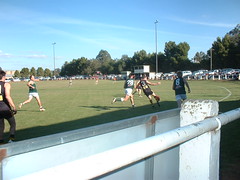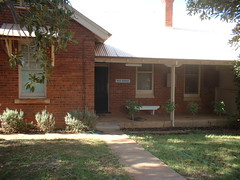I had good intentions to blog my daily doings at AERA but that didn't happen. The conference seemed to go very quickly this year, I suspect in part because my papers were on the Monday and so everything (for me) was leading up to those. They were co-authored papers and so some time prior to Monday was needed for working on powerpoints and the nitty gritty of who was going to say what.
Overall, I think this was my best AERA ever and there were several reasons for that. This year I again completed a workshop. This one was on designing qualitative methods courses/subjects. The workshop went for four hours and was conducted by three experienced academics from the US. Since I designed and wrote a number of courses on research when I was at CQU, I was interested to see how others (including much more experienced others) approached this kind of postgraduate instruction. The session was informative and included a new of opportunities for interaction with the presenters in small groups. The workshop was definitely a highlight of the conference.
I attended a couple of paper sessions from the Doctoral Education SIG and I also attended their annual meeting. From what I can gather, this is a relatively new SIG. It also has a number of OZ academics in it. People are very friendly and enthusiastic about the opportunities that a focus on Doctoral Education provides. I've joined the SIG this year and will do some thing in the near future about how I could develop research which might allow me to present papers in this SIG at future meetings of AERA.
Now to my own sessions. Both co-authored papers focused on transcription. One reported research that examined the use of transcription in PhD thesis in education. This has been a very interesting study and certainly a useful one in relation to my own understandings of "the thesis" and how various methodologies inform doctoral work. More specifically, our paper showed some interesting differences across methodologies in relation to how transcription was reported and how transcripts were used (both in the conduct of research and its reporting).
The second co-authored paper with Dr Robyn Brandenburg was presented at a paper session for the Self-study SIG. The paper examined Robyn's experience of transcription in her own doctoral work - we used the literature on transcription to draw out and examine aspects of Robyn's approach. The actual presentation was interesting (although challenging in some ways). Usually, presentations at this SIG are to small groups so they are as interactive as possible. Robyn and I had therefore planned out session with that in mind. However, the chair of the session decided that it would be better to do a whole group presentation and so this meant that all presenters had to quickly rethink how they were going to do things. For Robyn and me, this meant that we alternated commentary between the two of us. With Robyn sharing her recollections and me chiming in every now and then to make connections to the literature. Our discussion points encompassed the ways that Robyn had actually used transcription as the beginnings of analysis and (importantly) how she had arrived at a definition of transcription that had a good fit with the methodology of self-study. for me, the latter point was the most exciting because it illustrates the way that understandings of transcription can and should align with all aspects of study design, including the methodology that informs the study.
On the last morning of the conference, I attended another self-study session. I was pretty impressed with a couple of the papers. I'm an outsider to the self-study group but I have noticed that there is an increasing interest in developing/extending the approach in certain ways (and I've leave self-study people to articulate what those need to be or might be). Again, the members of this SIG are very welcoming and supportive of each other.
So, that's twice now that I've referred to specific SIGS being 'friendly'. I guess it comes to matter at AERA because it is a big conference and making connections with other folk is important. A number of friends of mine have spoken about their first AERA conference as a lonely and alienating experience. Seeking out a responsive SIG is one way in.
Having said all of that, I still acknowledge participation in AERA as one of the most important steps in getting my publications going. I've thoroughly embraced the cycle of developing the big proposals for the conference(2,000 words), then uploading the final paper some weeks before attendance in order to get feedback from the discussant. and then of course, turning at least one of those papers into a journal article. I like structure and AERA has provided that for me with good outcomes. Along the way, I've connected with some good academics and seen some great parts of the US (San Francisco, Chicago, New York, San Diego, Denver). Now, it's almost time to start thinking about New Orleans or 2011.


